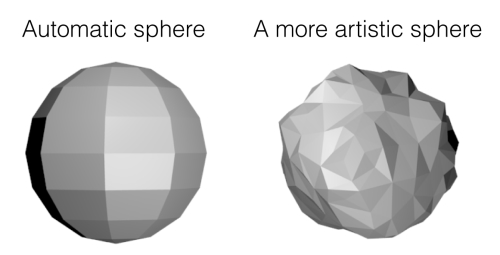In the early days of 3D games, the number of polygons was a much more critical issue than today, even in such delicate domains as mobile devices. The calculation power of hardware was pretty limited. This means that game developers had to adjust the overall number of polygons in a scene to a specific minimum level. Each game object should have the lowest number of geometric faces for the game to run smooth and fast. For example, a character in the original Quake from id Software, published in 1996, was constructed using 200 polygons (many modern games spend more than ten thousand tris). Game designers always tried to make games as realistic as possible because the craft of 3D modeling was based on two opposite points: an economy of polygons and an ambition to make the 3D model look fine.
To find the correct balance, various tricks in 3D modeling and texture design were used.

Nowadays, this intention has successfully transformed into a form of art. The past was reinvented for creative purposes. Low poly graphics are not only a technical need anymore, but additionally, an approach to present 3D models in an interesting visual way, thus brandishing polygons. The most obvious analogy is the 8-bit-like graphics in many indie games that are not about the hardware or screen resolution, but only a question of visual style. The graphics look sharp, minimalistic, and clear, having some pleasant connotations, talking about a past that we are all recalling with some warm feelings. It can be considered as a story fused in artwork. Low poly models, in a similar case, let some players drift back for more than a decade, switching on memories about the night spent playing Quake, Heretic II, Half-Life, and so on. This experience cannot be forgotten because for that period of time, each 3D game was a real breakthrough and the graphics were a symbol of the technical revolution. That is why, from a semantic point of view, low poly graphics are perceived by the audience to be more 3D-ish than any complex 3D model made up of thousands of polygons; simply put, a rough wooden taboret expresses the idea of woodenness better than any elegant cabinet made of redwood.
One of the creative advantages of minimalistic 3D models is their cuteness. Incredibly, but in most cases, low poly characters (if they were done with some style) are perceived as very sweet because they look like laconic toys made of paper or wood. Just for example, try to create the simplest game hero ever made of several cubes and parallelepipeds, and you will see that it looks very cute like an attractive paper craft discovered on the Internet.
Thus, using low poly art in a mobile 3D game, you may catch a few birds with one stone. The game is rendered fast, even on legacy devices. It looks pretty stylish and 3D models are quite easy to produce. But of course, there are disadvantages, such as minimum level of details, a generalized look for all objects, and imperfect curved surfaces.
Here's an improvised receipt of a good low poly model:
- Faces: These are shown intentionally. The model has a faceted design. Stealth aircrafts are a pretty good source of inspiration as well as the design of many Lamborghini cars.
- Simple look: The design is minimalistic. There are no tiny details and complex surfaces, as if the model should be easily gummed up of paper.
- A circle has four angles: In low poly models, there are no circles. They are replaced with rectangles, trapezes, or pentagons (octagons, in this case, look like a real luxury). The idea is that the circle element is fully reinterpreted, not simply surrogated with a more primitive shape.
- Non-realistic proportions: Because the style itself is not pretty naturalistic, it is better to use a more creative approach on the character's proportions: bigger heads, short arms, and short legs.
- Controlled mess: The faces should not look like they are being placed by a machine, such as automatically created tris in a default sphere created in 3D editors, especially if the model illustrates some natural objects such as rocks or tree crowns. There should be some individuality and manual craft in the order of the vertexes.
- Large minimalistic textures: In contrary to low poly modes used in early games, the textures can be larger; they should not be blurry. Their design must be based on laconic geometric shapes, clean colors without gradients, or any photorealistic structures.
- Sharp animation: Movement of objects and character should obey the overall tone of the graphics. Any moves must be a little bit sharp and non-linear as in stop-motion animation.
Astronaut is Gone is based on low poly 3D graphics as well. All elements are made up of simple shapes and do not have a large number of tris.
